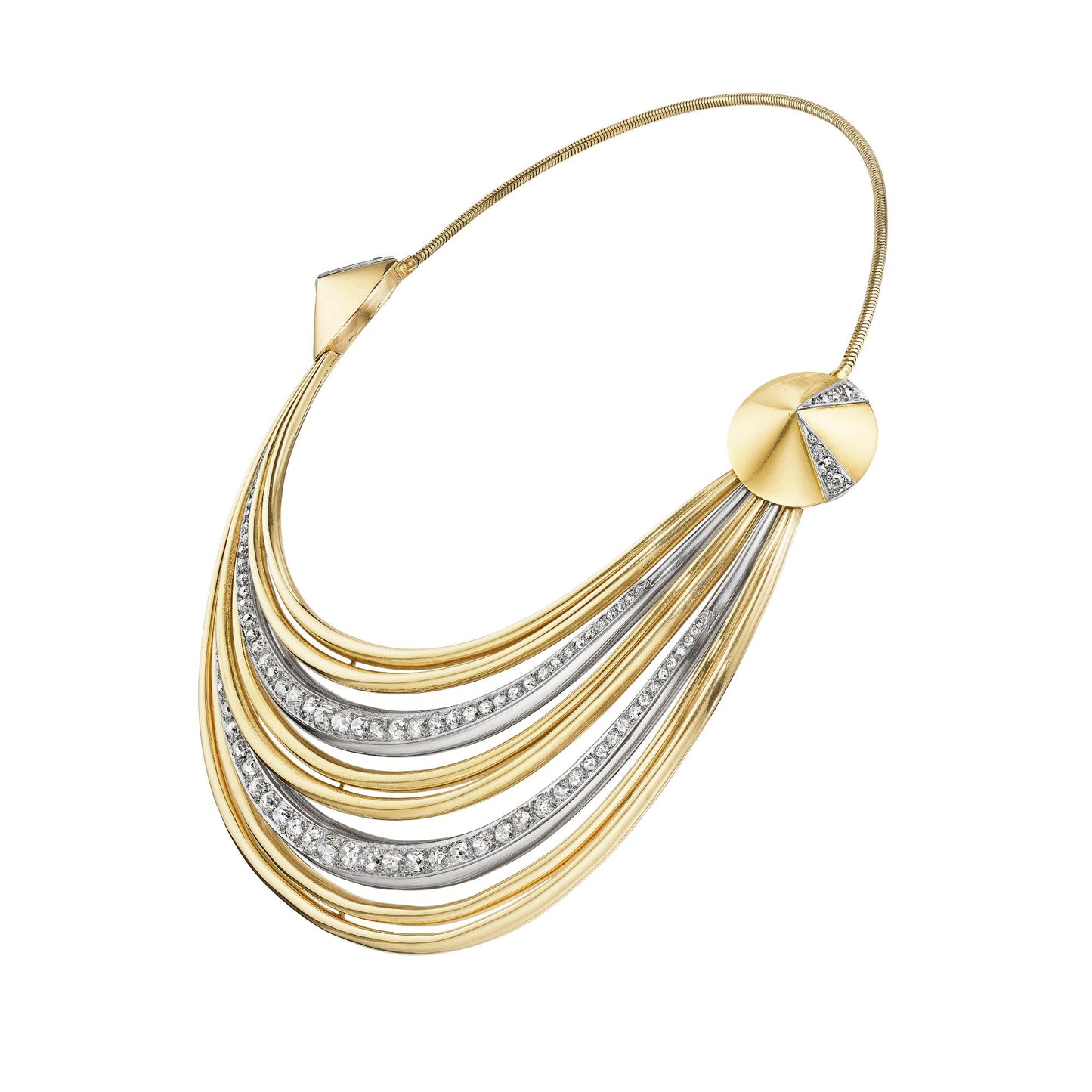ART MODERNE GOLD, PLATINUM, AND DIAMOND NECKLACE BY SUZANNE BELPERRON, PARIS, CIRCA 1940
ART MODERNE GOLD, PLATINUM, AND DIAMOND NECKLACE BY SUZANNE BELPERRON, PARIS, CIRCA 1940
SOLD
A bib necklace featuring gold and platinum alternating curved bands as the centerpiece; set with European- and old mine-cut diamonds; capped by conical terminals with diamond accents; attached by a snake chain; mounted in platinum and 18-karat gold
- European- and old mine-cut diamonds, total weighing approximately 14 carats
- Inner Circumference: 15 inches
Additional cataloguing
Certification
Olivier Baroin Certificate of Authenticity no. 200311, dated March 11, 2020, stating the necklace is Suzanne Belperron designed circa 1935, manufactured circa 1942 by Groené et Darde.
Literature
Corbett, Patricia, et. al. Jewelry by Suzanne Belperron. London: Thames & Hudson, 2015, p. 178 (on the desk).
Femina, December, 1948.
Raulet, Sylvie, and Olivier Baroin. Suzanne Belperron. New York: Antique Collector’s Club, 2011, p. 211.
Vogue Paris, February 1948.
Biography
Along with Chanel and Schiaparelli, Suzanne Belperron was one of the innovators of modern style. Belperron began her career in 1919 designing for René Boivin. Her 1933 partnership with Bernard Herz (and later his son Jean) allowed her to develop her bold, imaginative style mixing hardstones, such as chalcedony and rock crystal, with precious stones, such as diamonds and sapphires. The elegant beauty became a favorite jeweler to the fashionable elite including Diana Vreeland, Colette, Elsa Schiaparelli, and Wallis, Duchess of Windsor. Belperron retired in 1974 and continued consulting on jewelry designs until her death in 1983.
Significance
Stripping away any assumptions about the delicacy of jewelry design, Suzanne Belperron created the most innovative jewels of the twentieth century. Exhibiting bold curves and rounded forms, her jewels are works of art with an expert sense of proportion and color. Belperron looked to nature, geometry, and ancient civilizations for inspiration, and always added the clean modern lines of a machine. An article in Harper’s Bazaar in 1938, described Belperron as living surrounded by Chinese furniture and art, as well as books on ancient Assyrian jewelry. Photographs capture her dressed in an exotic silk kimono or modeling Paul Poiret’s silk turban.
The necklace takes inspiration from African neckpieces. Gold segments alternating diamond-set platinum lines evoke a stack of necklaces used to convey strength and power. Belperron gave her necklace stack a cool machine-age edge with the use of smooth high polished gold and platinum. In a subtle move, she left space in between each segment, underscoring the visual idea of layered necklaces. The corners are fixed with rivets of polished gold, with diamond-set slices in the shape of a highlight. The clasp is hidden cleverly under one of the rivets.
Belperron created this design around 1935, and it was an important piece throughout her career. In 1948, the necklace appeared in advertisements in both Femina magazine and Vogue. The necklace surfaced again in 1951 front and center on Belperron’s desk in a publicity portrait. In 1980, Belperron received a letter from a friend and prolific client, Aimée de Heeren, who begged Belperron to make her a necklace she saw at Herz in 1939, and the drawing is undoubtedly this piece. In more than 40 years, she had not forgotten the power of this striking piece. This iconic necklace is a jeweled work of art and an important piece for any collector.















